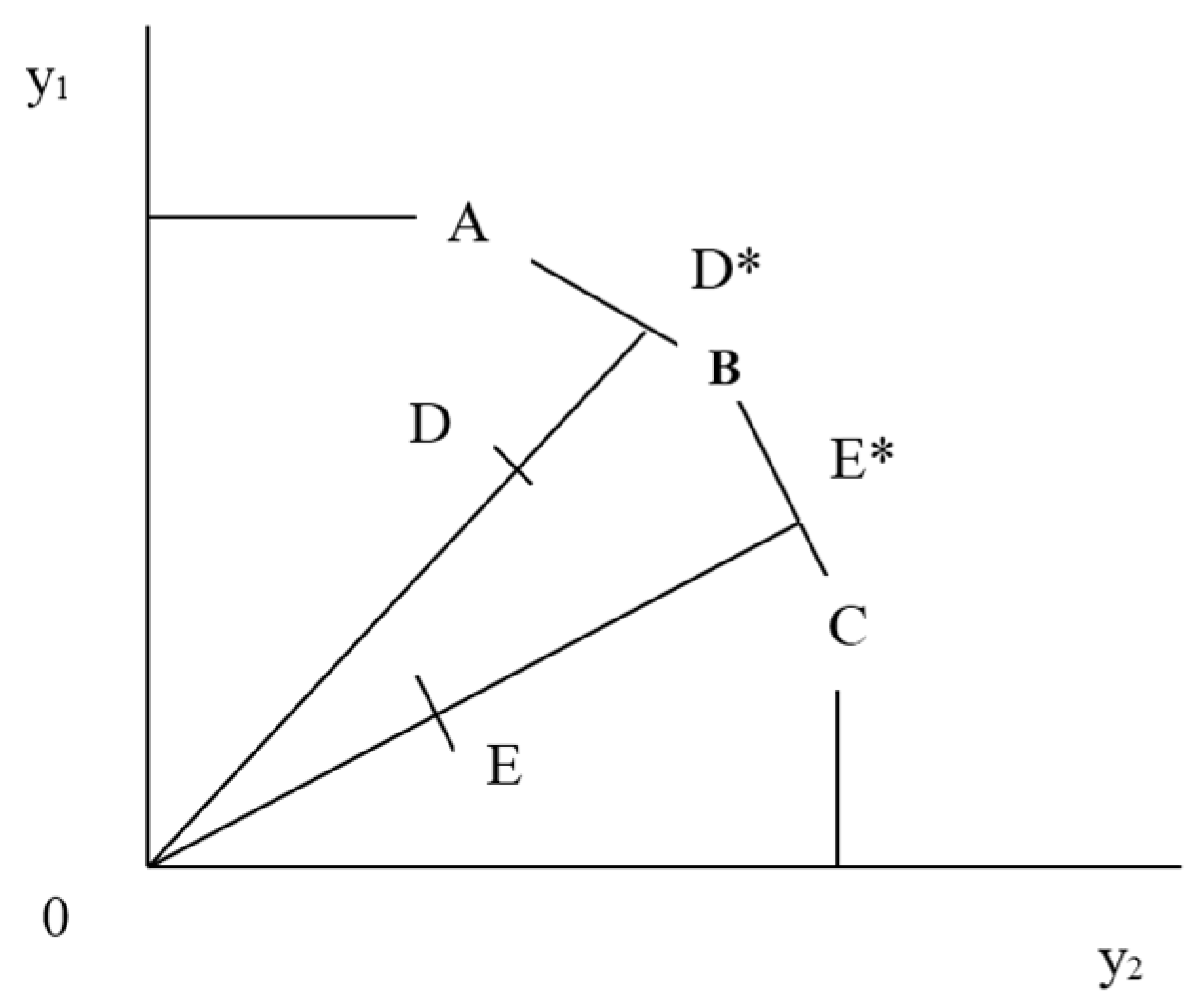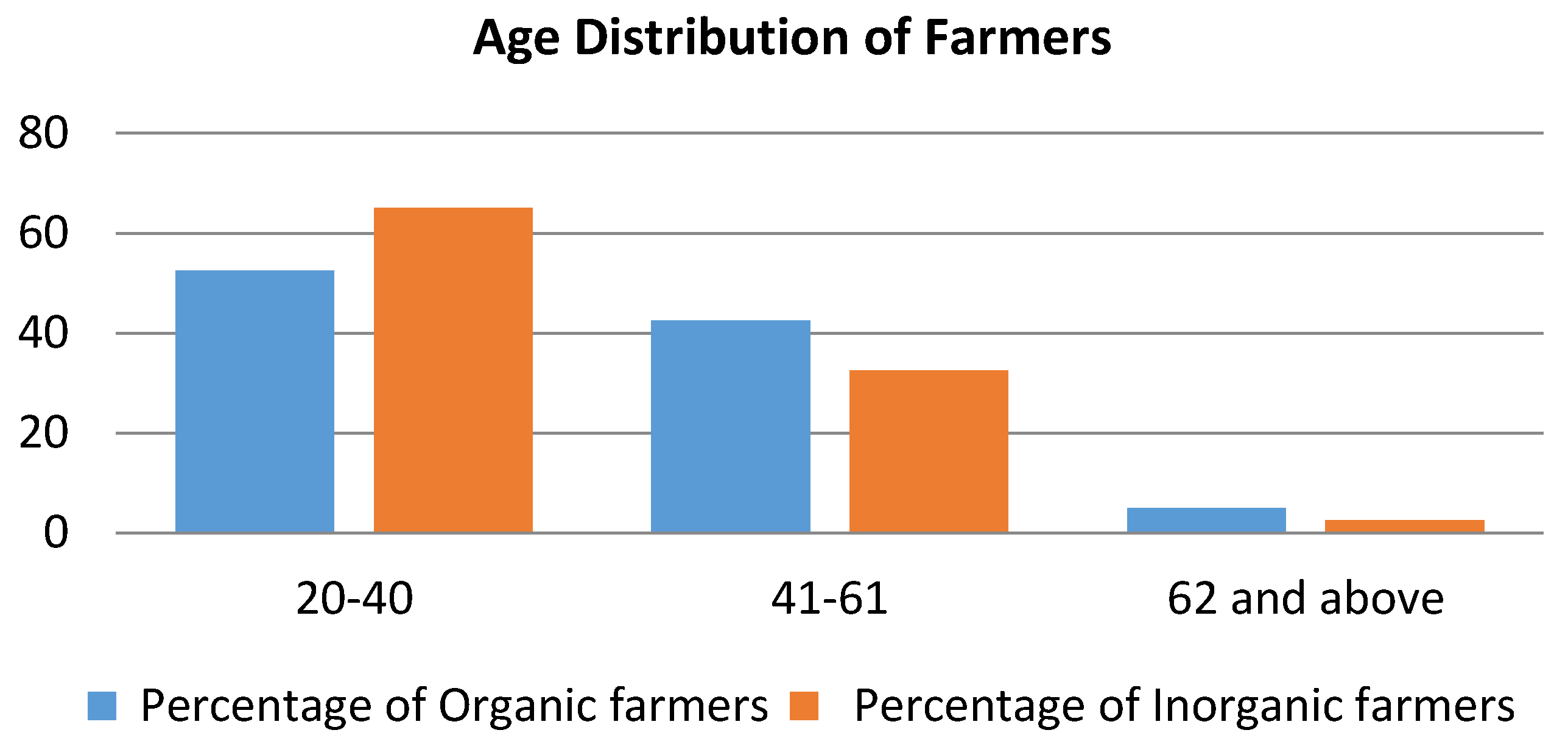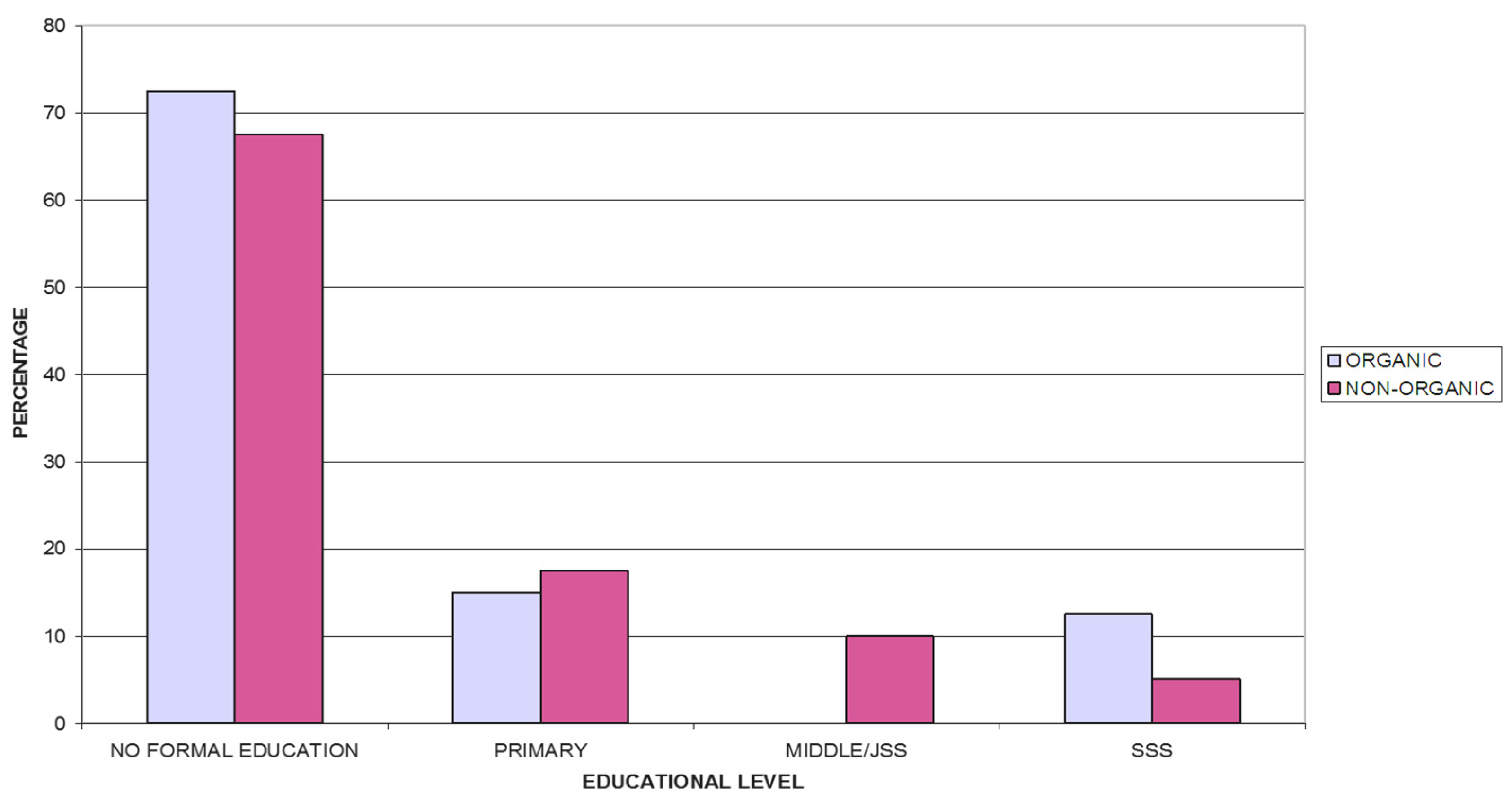A Comparative Analysis of Productivity among Organic and Non-Organic farms in the West Mamprusi District of Ghana
Abstract
:1. Introduction
2. Experimental Section
2.1. The study Area
2.2. Method of Data Collection
2.3. Method of Data Analysis
2.4. Malmquist TFP Indices
2.5. The Data
2.6. Output Series
2.7. Input Series
3. Results and Discussion
3.1. Demographic Characteristics of the Respondents
3.1.1. Age and the Decision to Engage in Organic Agriculture
3.1.2. Gender and the Decision to Engage in Organic Agriculture
3.1.3. Educational Status and the Decision to Engage in Organic Agriculture
3.1.4. Overview of the Results from the Malmquist Indices
3.2. Discussion
4. Conclusions
Acknowledgments
Author Contributions
Conflicts of Interest
References
- Ministry of Food and Agriculture. Medium Term Agricultural Sector Investment Plan (METASIP). Ministry of Food and Agriculture: Accra, Ghana, 2011. [Google Scholar]
- Baah, O. Technology Policy and Practice in Africa; Ogbu, Osita M., Oyeyinka, Banji O., Mlawa, Hasa M., Eds.; The International Development Research Centre (IDRC): Ottawa, ON, Canada, 2006. [Google Scholar]
- Fulginity, L.E.; Perrin, R.K. Productivity in LDC Agriculture: Non-parametric Malmquist Measures; Center for Agricultural and Rural Development: Ames, IA, USA, 1994. [Google Scholar]
- Havlin, J.L.; Beaton, J.D.; Tisdala, S.L; Nelson, W.L. Soil Fertility and Fertilizers, 7th ed.; Prentice Hall: Englewood Cliffs, NJ, USA, 2000. [Google Scholar]
- Follet, R.H.; Murphy, L.S.; Donahue, R.L. Fertilizers and Soil Amendments; Prentice Hall: Englewood Cliffs, NJ, USA, 1981. [Google Scholar]
- Yadav, A.K.; Chaudhary, S.R.; Talukdar, N.C. Biotechnology in Sustainable and Organic Farming; Shree Publisher and Distribution: New Delhi, India, 2004. [Google Scholar]
- Harris, J.M. Basic Principles of Sustainable Development; Global Development and Environment Institute: Medford, MA, USA, 2000. [Google Scholar]
- IFOAM. Available online: http://www.ifoam.bio/en/organic-landmarks/definition-organic-agriculture 2005 (accessed on 20 August 2015).
- Research Institute of Organic Agriculture (FIBL); International Federation of Organic Agriculture Movements IFOAM. The World of Organic Agriculture: Statistics and Emerging Trends 2014; Medienhaus Plump: Rheinbreitbach, Germany, 2014. [Google Scholar]
- Godfray, H.C.J.; Beddington, J.R.; Crute, I.R.; Haddad, L.; Lawrence, D.; Muir, J.F.; Pretty, J.; Robinson, S.; Thomas, S.M.; Toulmin, C. Food security: The challenge of feeding 9 billion people. Science 2010, 327, 812–818. [Google Scholar] [CrossRef] [PubMed]
- De Ponti, T.; Rijk, B.; van Ittersum, M.K. The crop yield gap between organic and conventional agriculture. Agric. Syst. 2012, 108, 1–9. [Google Scholar] [CrossRef]
- Badgley, C.; Moghtader, J.; Quintero, E.; Zakem, E.; Chappell, M.J.; Avilés-Vàzquez, K.; Samulon, A.; Perfecto, I. Organic agriculture and the global food supply. Renew. Agric. Food Syst. 2007, 22, 86–108. [Google Scholar] [CrossRef]
- Hepperly, P.; Douds, D.; Seidel, R. The rodale farming systems trial, 1981 to 2005: Long-term analysis of organic and conventional maize and soybean cropping systems. In Long-Term Field Experiments in Organic Farming; Raupp, J., Pekrun, C., Oltmanns, M., Köpke, U., Eds.; International Society of Organic Agriculture Research (ISOFAR): Bonn, Germany, 2006; pp. 15–32. [Google Scholar]
- Pretty, J.N.; Noble, A.D.; Bossio, D.; Dixon, J.; Hine, R.E.; Penning de Vries, F.; Morison, J. Resource-conserving agriculture increases yields in developing countries. Environ. Sci. Technol. 2006, 40, 1114–1119. [Google Scholar] [CrossRef] [PubMed]
- Coelli, T.J.; Rao, D.S.P.; O’Donnell, C.J.; Battese, G.E. An Introduction to Efficiency and Productivity Analysis; Springer Science: New York, NY, USA, 2005. [Google Scholar]
- Donkoh, S.; Awuni, J. Adoption of farm management practices in lowland rice production in Northern Ghana. J. Agric. Biol. Sci. 2012, 2, 84–93. [Google Scholar]
- Akudugu, M.A.; Guo, E.; Dadzie, S.K. Adoption of modern agricultural technology by farm households in Ghana: What factors influence their decisions? J. Biol. Agric. Healthc. 2012, 2, 1–13. [Google Scholar]
- Otieno, Z.; Okello, J.; Nyikal, R.; Mwang’ombe, A.; Clavel, D. The role of varietal traits in the adoption of improved dry land crop varieties: The case of pigeon pea in Kenya. AFJARE 2001, 6, 176–193. [Google Scholar]



| Organic | Conventional | |
|---|---|---|
| Efficiency Change (EFFCH) | 1.072 | 1.018 |
| Technical Change (TECHCH) | 0.605 | 0.651 |
| Total Factor Productivity Change (TFPCH) | 0.648 | 0.663 |
| Constraints of Organic Farming | Constraints of Conventional Farming |
|---|---|
| The labour intensive nature of compost preparation has resulted in smaller organic farm sizes | High cost of inorganic fertilizer and pesticides makes it difficult for farmers to apply the recommended amounts of inputs |
| Lack of appropriate implements and tools makes compost preparation tedious | Poor access to credit makes it difficult to expand production |
| Poor access to credit makes it difficult to expand production | Inadequate extension support makes it difficult to make efficient use of inputs |
| Organic products are not differentiated from conventional farm products making it difficult for organic farmers to earn more from the extra effort required under organic production | Inaccessible farm machinery for land preparation results in a high cost of ploughing, further constraining farm expansion |
© 2016 by the authors; licensee MDPI, Basel, Switzerland. This article is an open access article distributed under the terms and conditions of the Creative Commons by Attribution (CC-BY) license (http://creativecommons.org/licenses/by/4.0/).
Share and Cite
Issaka, Y.B.; Antwi, M.; Tawia, G. A Comparative Analysis of Productivity among Organic and Non-Organic farms in the West Mamprusi District of Ghana. Agriculture 2016, 6, 13. https://doi.org/10.3390/agriculture6020013
Issaka YB, Antwi M, Tawia G. A Comparative Analysis of Productivity among Organic and Non-Organic farms in the West Mamprusi District of Ghana. Agriculture. 2016; 6(2):13. https://doi.org/10.3390/agriculture6020013
Chicago/Turabian StyleIssaka, Yakubu B., Moses Antwi, and Gladys Tawia. 2016. "A Comparative Analysis of Productivity among Organic and Non-Organic farms in the West Mamprusi District of Ghana" Agriculture 6, no. 2: 13. https://doi.org/10.3390/agriculture6020013





